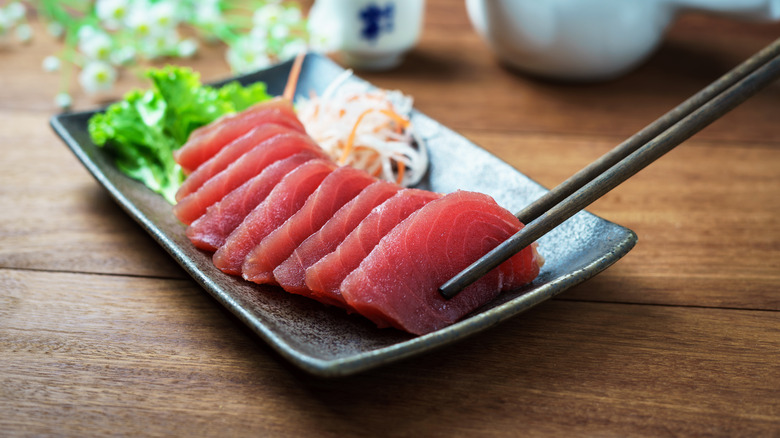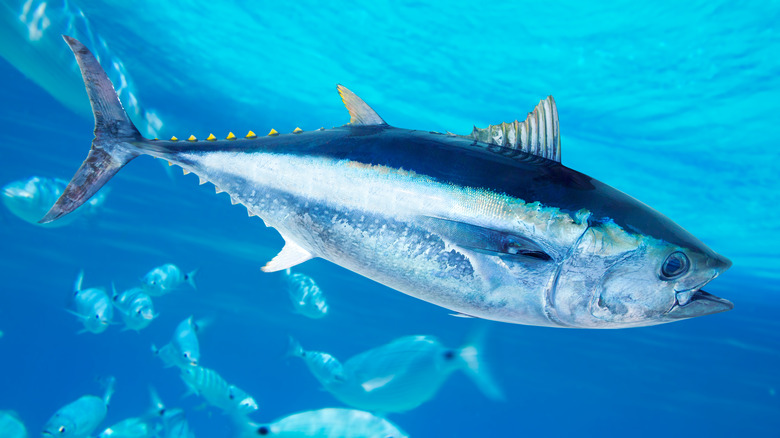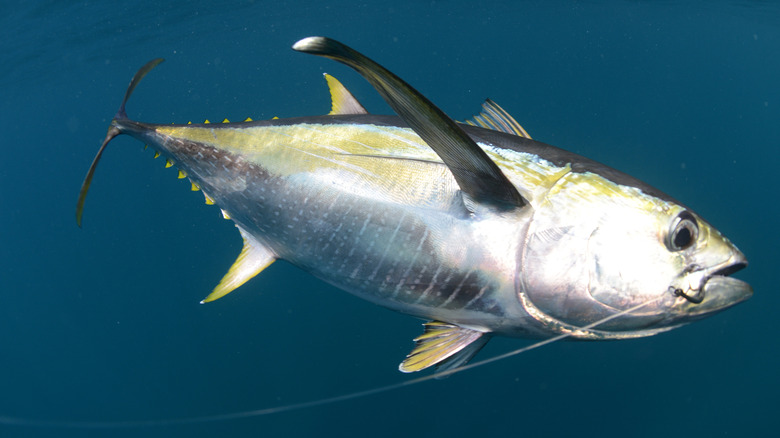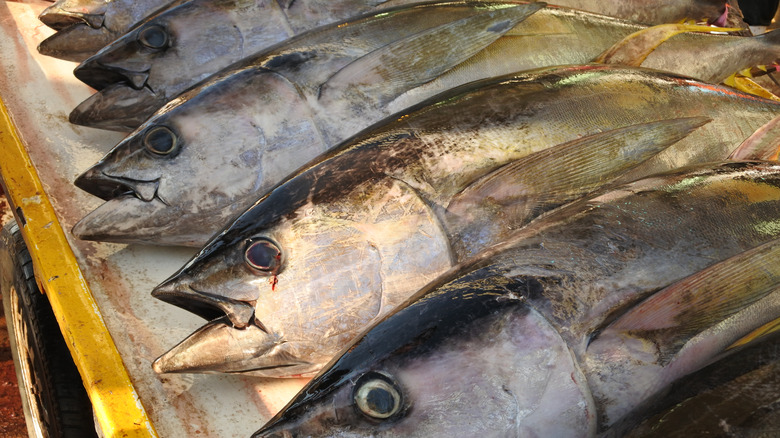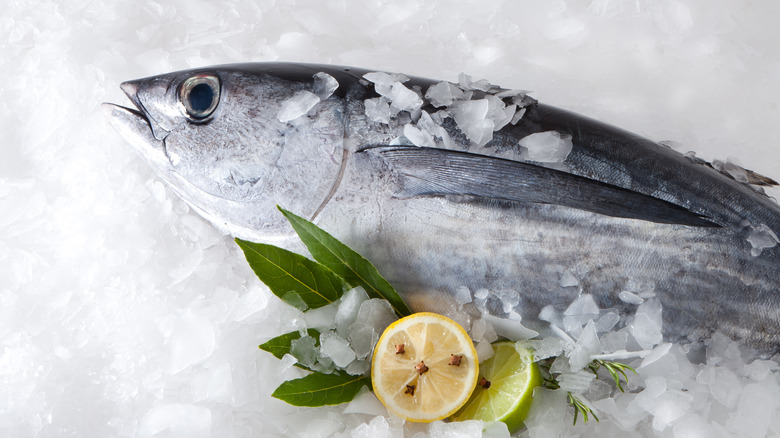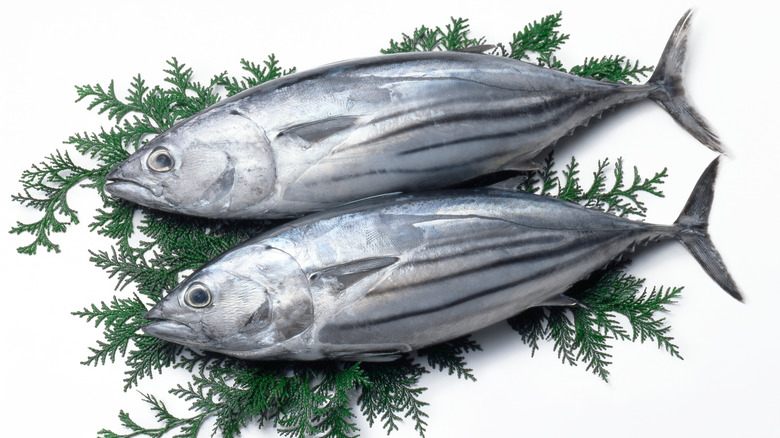The Most Popular Types Of Tuna Used In Japanese Cuisine
A tapestry of flavors, techniques, and traditions, Japanese cuisine prioritizes freshness and quality of ingredients, with tuna holding a special place in the country's culinary practices. With unique characteristics, this sea creature contributes to the diversity of Japanese gastronomy and holds a pinnacle place in the sushi hierarchy as a notable symbol of the popular Japanese food.
However, although many associate tuna with Japanese cuisine, it may be surprising to know that tuna was considered undesirable until fairly recently. Previous to modern times, tuna was considered an inferior fish, and only eaten by the poor. It was not until the mid-19th century that tuna became more accepted, thanks to an unexpectedly large harvest at the time, but even then, the fatty parts that now fetch the most money were still considered more or less trash food.
Like lobster, another seafood that has was regarded as a luxury item over time, fatty tuna became more popular in the first half of the 20th century as refrigeration kept it fresher for far longer. Today, tuna is one of the most prized fishes in Japanese cuisine with many different kinds that serve different purposes, including these popular types.
Bluefin tuna
The titan of the tuna world, Bluefin tuna is the largest and the most well-known among the species. These behemoths can reach lengths of up to 10 feet and weigh well over 800 pounds. Their robust, torpedo-shaped bodies are adorned with dark blue and black coloring on the upper half, fading into a silvery-white shade on the lower half.
There are in fact three types of bluefin tuna: Pacific, Atlantic, and Southern. Pacific bluefin tuna (scientific name Thunnus orientalis) spawns around Japan and migrates across the Pacific Ocean to the west coast of North America. Meanwhile Atlantic bluefin tuna (Thunnus thynnus) spawns in the Mediterranean and migrates across the Atlantic to eastern North America. Southern bluefin tuna (Thunnus maccoyii) lives in the southern hemisphere and is caught during Japanese summers when northern hemisphere species are not as fatty.
Bluefin tuna's claim to fame lies in its exceptionally rich, marbled flesh. The color of its meat ranges from deep red to pale pink, depending on the cut. What truly distinguishes Bluefin tuna is its high-fat content, which imparts a buttery texture and wonderful flavor. This rich and luxurious fish is used primarily for sashimi and sushi, with prized cuts like "otoro" (fatty belly) and "chu-toro" (medium fatty belly) commanding top billing at upscale sushi bars.
Yellowtail tuna
Yellowfin tuna (Thunnus albacares) is the middle child in the tuna family, known for its leanness and versatility. They are smaller than their Bluefin counterparts, with the biggest specimen measuring up to 8 feet in length and weighing up to 440 pounds. Yellowfin tuna boast a bright yellow stripe alongside more typical coloring on its sides, and they are often fished off the shores of Japan.
Yellowfin's flesh characteristics are not as noteworthy. It features firm, deep pink to reddish meat with a mild flavor. Unlike the bluefin tuna, yellowfin is not a fatty fish, and therefore there are no special cuts such as chu-toro to get from this species. As such, its lower fat content gives it a clean and crisp texture, allowing diners to indulge in cravings without the overwhelming richness of other types of the fish.
Yellowfin tuna also shines in sashimi and sushi. In Hawaii, the fish is called ahi, and you can find it used in poke bowls where it's paired with Japanese rice, edamame soybeans, seaweed, and sauces. You can also find ahi tuna in many non-Japanese restaurants, where it's served tartare or seared with a sesame crust.
Bigeye tuna
Bigeye tuna, scientifically known as Thunnus obesus, stands as an intermediate between Bluefin and Yellowfin in terms of size and characteristics. This type of fish is smaller than bluefin, although the two do share some physical traits. They both sport a robust build, dark blueish-black coloring on the upper half, and silver shades on the lower half. As its name suggests, the Bigeye tuna species is distinguished by its enormous peepers.
What truly sets Bigeye apart is its flesh, which falls between Yellowfin and Bluefin in terms of fattiness. Its meat ranges from pale red to a much darker hue depending on the age of the fish. Raw Bigeye tuna is slightly fatty, firm, and tender, with a clean taste without any trace of fishiness. In Japanese cuisine, Bigeye tuna is an extremely popular fish to be served as sushi and sashimi. In Hawaii, it's also named ahi (just like yellowfin tuna), and therefore is used in a similar manner.
Albacore tuna
Albacore tuna (Thunnus alalunga) are smaller, typically measuring 3 to 4 feet in length, with a more elongated body. Their appearance showcases a metallic blue-black coloring on the upper half and silver-white hue on the lower half.
Albacore tuna stands out for its pale pink to white flesh that offers a mild, delicate flavor with a slightly firmer texture than Bluefin. Its pale color has led it to be called "white tuna," a name that is shared with escolar, a fish that is not part of the tuna family. Since it is considerably less expensive than other tuna species, Albacore is often served in conveyor sushi establishments, where diners pluck plates in a convenient assembly style fashion.
Albacore is also frequently canned, and can be found in markets around the world. In Japan, it can be used for a tuna salad that's stuffed inside traditional rice balls sold in convenience stores.
Skipjack tuna
Skipjack tuna (Katsuwonus pelamis) is the smallest of the tuna species that are commonly used in Japanese cuisine. They typically measure less than 2 feet in length. Skipjack tuna, also known as bonito, showcases a streamlined body with metallic blueish-black coloring on the upper half and silver-white on the lower half, akin to other tuna species.
What makes Skipjack distinctive is its moderate fat content. Its meat is light pink to reddish in color and has a stronger flavor compared to other kinds of tuna, sometimes compared to the taste of mackerel. It is a popular fish for sushi in Japan, but seldom seen outside the country as its flesh spoils quickly. It's a popular fish to be prepared tataki style, which sears the fish on the outside while maintaining its raw interior.
However, Skipjack's claim to fame lies in its role as the primary source for "katsuobushi," when filets are smoked and fermented an extremely hard to the touch. When shaved with a special instrument, bonito flakes are a vital ingredient in dashi, a foundational Japanese stock used in countless dishes, including soups, sauces, and stews. Bonito is also used in Japanese cuisine as a garnish for certain dishes.

